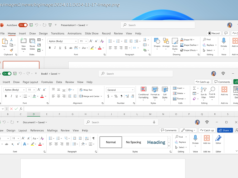Product reviews are weird in 2020, and no device I’ve seen this year has been weirder than the Microsoft Surface Duo. Microsoft’s return …
Product reviews are weird in 2020, and no device I’ve seen this year has been weirder than the Microsoft Surface Duo. Microsoft’s return to phones takes the form of a dual-screen, hinged, foldable Android device that looks like two tiny iPads bonded together. Its two 5.6-inch OLED screens form an 8.1-inch display, bound together by a unique hinge that Microsoft says has been in the works for years. It’s 9.9 millimeters thick when closed,4.8mm when open, weighs 8.8 ounces (250 grams) and costs $1,200 for the starting configuration, with 128GB of storage. International prices aren’t yet available, but $1,200 converts to about £920 or AU$1,700. Read more: Unboxing Microsoft’s Surface Duo: Here’s what comes with the dual-screen phone I’ve been skeptical about dual-screen devices, and I wasn’t sure how I’d feel about the Surface Duo. Wannabe version of Samsung’s possibly even more expensive Galaxy Z Fold 2? (Here’s how the Surface Duo compares to the Galaxy Z Fold 2 and Motorola Razr.) Weird tiny dual-screened version of the Microsoft Surface tablet? Something more? Inside a little white box in front of me is a gadget that looks like a little book. The Microsoft Windows logo is embossed on top. I open it, bending it a few times. I feel like I’m holding a small Moleskine notebook, made of glass and metal. Inside? No displays. Just circuitry through glass. This isn’t a working version of the Microsoft Surface Duo being unveiled today. This is a special see-through prototype sent to me in advance just so I can see the circuits and feel how the hinge works. I haven’t had a chance to use an actual working device yet. Instead, I got this specially made, see-through prototype. Kind of ridiculous. And yet, even holding it, I’m already falling in love with the feel of the thing. This feeling isn’t new. Back in 2004, I remember opening up an absurd two-screen device that I felt was sure to fail. It had a stylus. It promised twice the viewing area for whole new experiences. I thought it was insane. It was the Nintendo DS, and I soon realized it was a lot more amazing than I expected. I think about that Nintendo DS whenever I see a product with dual screens or folding screens. But I think about it the most when holding a nonworking shell of the Surface Duo for the first time. I’ve seen the Galaxy Fold, and the Moto Razr, and all the other dual-screen laptops and tablets that seem to be sprouting up like weeds. The Duo seems a lot more like a Nintendo DS or some sort of magic Moleskine. It’s tiny. But not that tiny. It depends on whether you’re perceiving it as a tablet, a phone or a funky digital book. Microsoft promised to reinvent the idea of dual-screen computing with the Surface Duo and Neo a year ago. The Surface Neo, which will boast two 9-inch screens, has been delayed until 2021. But the Duo is arriving in a few weeks, sooner than expected, maybe right alongside Samsung’s new Galaxy Fold update, in the middle of a pandemic year where everyone’s budget has collapsed and their need for gadgets has become a lot more practical. The Duo is a phone, but Microsoft clearly doesn’t want to call it a phone. Maybe what Panos Panay, head of Microsoft’s devices business, told me and CNET editor Ian Sherr last week will turn out to be true. Maybe it really is a new device category. I told my kids I was going to review a dual-screened, phone-slash-tablet thing from Microsoft. My oldest son looked at the folding nonworking device and said, “That’s weird.” But my youngest son was totally into it. “Whoa, does that mean you can play two games at the same time?” My oldest son says his younger brother is an optimist while he’s more of a realist. It’s also interesting to hear how two kids who never saw a dual-screen thing besides the Nintendo 3DS react to the idea in the first place. Microsoft’s goal, here, is clearly to make the whole idea make sense from a multitasking perspective, helping to solve problems on phones that are already overburdened. I’ll say this much: Being stuck at home on infinite Zooms while trying to work has made me more aware of the need for multidisplays than ever before. Here’s what Microsoft’s proposition could mean for transforming the foldable device space — a space that clearly hasn’t taken hold yet, but which Google, Microsoft and a lot of other companies are trying to compete in, using physical folding devices and even wearable virtual ones. Will an extra screen solve Microsoft’s phone problems, or will it evolve phones into something many people might not even need? Or is Microsoft’s work on functioning, practical dual-screen apps the sort of necessary work these devices needed in the first place? “As it turns out, it might feel familiar, because there’s this thing, it’s called Windows,” Panay says about using the two-screened Duo.
Home
United States
USA — IT Microsoft Surface Duo's dual-screen hinge design is already winning me over






